Advanced UAV technology is transforming powerplant inspections, making them safer, faster, and more cost-effective. You'll find that drones can access hard-to-reach areas without shutdowns or scaffolding, reducing risks to personnel and minimizing downtime. High-resolution cameras and thermal imaging sensors on these UAVs provide improved data quality, allowing for early issue detection. You'll benefit from significant cost savings, as fewer workers and less equipment are needed. Drone inspections also offer enhanced accuracy and efficiency, giving you peace of mind and confidence in your maintenance decisions. As you explore this innovative approach, you'll discover how it's reshaping industrial maintenance practices.
Key Takeaways
- UAVs enhance safety by accessing hard-to-reach areas without exposing workers to hazards.
- Drones equipped with high-resolution cameras and thermal sensors provide improved data quality for early issue detection.
- Autonomous flight capabilities and AI-powered algorithms increase efficiency and accuracy of inspections.
- UAV inspections significantly reduce downtime and labor costs compared to traditional methods.
- Advanced drones navigate complex powerplant structures, offering comprehensive surveys without operational disruptions.
The Need for UAV Inspections
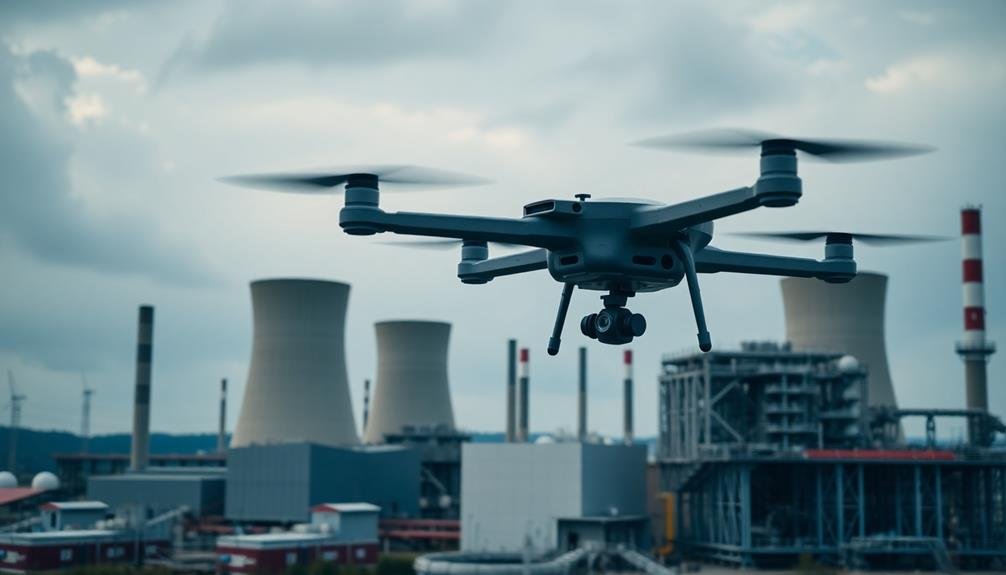
Safety concerns and operational efficiency drive the need for UAV inspections in powerplants. Traditional inspection methods often involve shutting down operations, erecting scaffolding, and sending workers into hazardous areas. These approaches are time-consuming, costly, and pose significant risks to personnel.
You'll find that UAV inspections offer a safer, faster, and more cost-effective alternative. They can access hard-to-reach areas without endangering human lives, reducing the risk of accidents and injuries. UAVs can perform inspections while the plant remains operational, minimizing downtime and revenue loss.
Moreover, you'll appreciate the improved data quality UAVs provide. Equipped with high-resolution cameras and sensors, they capture detailed imagery and measurements that human inspectors might miss. This precision allows for early detection of potential issues, preventing costly failures and extending equipment lifespan.
UAV inspections also enable more frequent assessments, allowing you to monitor asset conditions more closely. This proactive approach helps optimize maintenance schedules, reduce unexpected breakdowns, and improve overall plant reliability.
Benefits of Drone-Based Power Plant Inspections

Drone-based power plant inspections offer a multitude of advantages that extend beyond safety improvements.
You'll find that these aerial inspections considerably reduce downtime, as they're faster and more efficient than traditional methods. They can access hard-to-reach areas without scaffolding or shutting down equipment, allowing for more frequent and thorough inspections.
The high-resolution imagery and thermal cameras on drones provide detailed data that you can't easily obtain through manual inspections. This enhanced accuracy helps you identify potential issues earlier, preventing costly breakdowns and extending the life of your equipment.
You'll also appreciate the cost savings, as drone inspections require fewer personnel and less equipment than conventional methods.
Here are three key emotional benefits of drone-based power plant inspections:
- Peace of mind knowing your facility is thoroughly monitored
- Confidence in making data-driven decisions for maintenance
- Pride in adopting cutting-edge technology for improved operations
Types of UAVs for Industrial Use

When choosing UAVs for industrial use, you'll need to take into account the merits of fixed-wing versus rotary-wing drones.
You'll want to evaluate the payload capacity of different models to guarantee they can carry the necessary inspection equipment.
It's also essential to assess the autonomous flight capabilities of each drone, as this feature can greatly enhance efficiency and safety during powerplant inspections.
Fixed-Wing vs. Rotary-Wing Drones
In the domain of industrial drone applications, two primary types of unmanned aerial vehicles (UAVs) stand out from among the rest: fixed-wing and rotary-wing drones. Each type has its own strengths and weaknesses, making them suitable for different aspects of powerplant inspections.
Fixed-wing drones excel in covering large areas efficiently. They're ideal for surveying extensive powerplant grounds or long-distance power lines. With their airplane-like design, they can stay airborne for longer periods and achieve higher speeds. However, they require a runway or launcher for takeoff and landing, which can be limiting in confined spaces.
Rotary-wing drones, on the other hand, offer superior maneuverability. They can hover in place, fly at low speeds, and navigate tight spaces with ease. This makes them perfect for close-up inspections of powerplant structures, cooling towers, and intricate equipment.
When choosing between fixed-wing and rotary-wing drones, consider these emotional factors:
- Safety: Rotary-wings can access dangerous areas, reducing human risk.
- Efficiency: Fixed-wings cover more ground, saving time and resources.
- Precision: Rotary-wings provide detailed, up-close inspections, ensuring accuracy.
Ultimately, the choice depends on your specific inspection needs and the powerplant's layout.
Payload Capacity Considerations
Payload capacity plays an essential role in determining the effectiveness of UAVs for industrial applications. When choosing a drone for powerplant inspections, you'll need to evaluate the weight of sensors, cameras, and other equipment it can carry. Fixed-wing drones typically offer higher payload capacities, allowing you to equip them with more advanced inspection tools. This increased capacity enables longer flight times and more extensive data collection during a single mission.
Rotary-wing drones, while generally having lower payload capacities, offer greater maneuverability in tight spaces. You'll find them useful for close-up inspections of specific components or hard-to-reach areas. When selecting a UAV, assess the trade-off between payload capacity and maneuverability based on your specific inspection needs.
For powerplant inspections, you might require specialized equipment such as thermal cameras, LiDAR sensors, or gas detectors. Verify your chosen drone can accommodate these payloads without compromising flight performance.
Remember that increased payload weight affects battery life and flight duration, so you'll need to balance equipment needs with operational requirements. By carefully evaluating payload capacity, you'll optimize your UAV's capabilities for efficient and thorough powerplant inspections.
Autonomous Flight Capabilities
Autonomous flight capabilities represent a notable advancement in UAV technology for industrial applications. These features allow drones to navigate complex environments, avoid obstacles, and perform tasks with minimal human intervention.
You'll find that autonomous UAVs can greatly improve the efficiency and safety of powerplant inspections.
When selecting a UAV for industrial use, you'll encounter various levels of autonomy. Some drones offer basic features like automatic takeoff and landing, while others provide advanced capabilities such as:
- Collision avoidance systems that use sensors to detect and navigate around obstacles in real-time
- Intelligent flight modes that enable pre-programmed inspection routes and automated data collection
- AI-powered decision-making algorithms that can adapt to changing environmental conditions
You'll need to evaluate the specific requirements of your powerplant inspections when choosing the appropriate level of autonomy. Fully autonomous drones can operate in GPS-denied environments, making them ideal for indoor inspections or areas with poor satellite coverage.
Semi-autonomous UAVs, on the other hand, may require some human oversight but still offer considerable advantages over manually piloted drones. By leveraging these autonomous capabilities, you'll be able to conduct more thorough, efficient, and safer powerplant inspections.
Key Features of Inspection Drones

Inspection drones come packed with a range of features that set them apart from traditional inspection methods. You'll find high-resolution cameras capable of capturing detailed images and videos, even in low-light conditions.
These drones often incorporate thermal imaging sensors, allowing you to detect heat anomalies that might indicate equipment malfunctions or potential fire hazards.
Many inspection drones are equipped with obstacle avoidance systems, ensuring they can navigate complex power plant environments safely. They're also designed with robust frames and protective casings to withstand harsh conditions and potential impacts.
You'll appreciate their long battery life, enabling extended flight times for thorough inspections.
Some advanced models feature AI-powered image recognition software, which can automatically identify and flag potential issues. They're often integrated with data management systems, allowing for real-time transmission of inspection data to ground teams.
You'll also find drones with modular designs, enabling you to swap out different sensors or tools as needed for specific inspection tasks.
With their compact size and maneuverability, these drones can access hard-to-reach areas that would be dangerous or impossible for human inspectors to examine closely.
Thermal Imaging in Power Plant Surveys

Thermal imaging has revolutionized power plant surveys, offering a powerful tool for detecting hidden issues. You'll find that this technology allows you to identify potential problems before they escalate, saving time and money while enhancing safety.
By using infrared cameras, you can detect temperature variations that indicate equipment malfunctions, insulation breakdowns, or electrical faults.
When conducting thermal surveys in power plants, you'll be able to:
- Spot overheating components that could lead to catastrophic failures
- Identify energy loss areas, improving overall plant efficiency
- Detect potential fire hazards, ensuring the safety of workers and equipment
You'll appreciate how thermal imaging enables non-invasive inspections, reducing downtime and minimizing disruptions to plant operations.
This technology is particularly useful for examining hard-to-reach areas, such as high-voltage equipment and steam turbines.
Navigating Complex Power Plant Structures
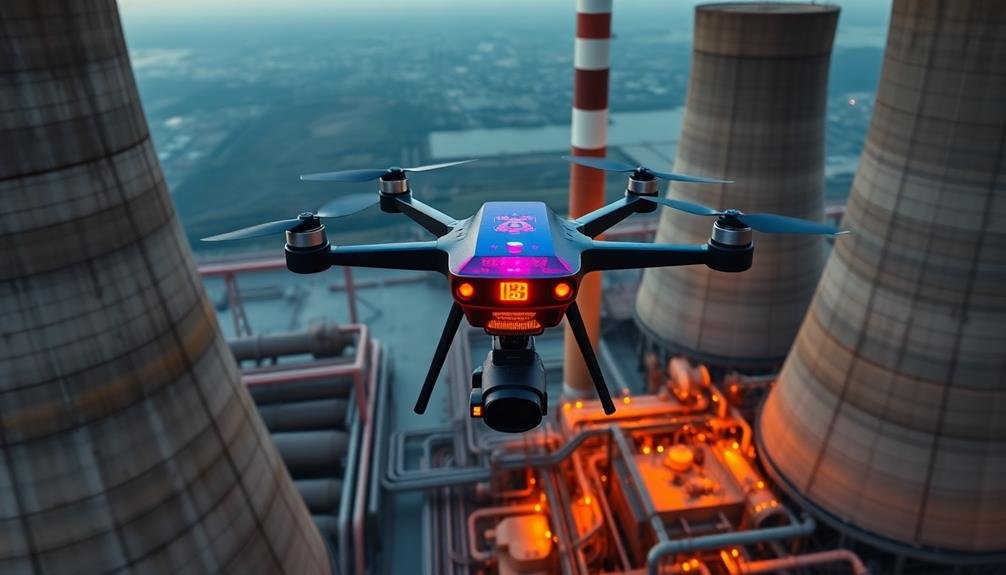
Within the labyrinthine layout of power plants, maneuvering through complex structures presents unique challenges for inspection teams. You'll encounter a maze of pipes, boilers, turbines, and cooling towers that demand careful navigation.
Traditional inspection methods often fall short in accessing hard-to-reach areas, risking safety and efficiency.
Enter advanced UAV technology. These drones are equipped with obstacle avoidance systems and precision flight controls, allowing you to navigate tight spaces with ease. You can program flight paths to cover every nook and cranny of the facility, ensuring thorough inspections.
The drones' compact size enables them to access areas that would be dangerous or impossible for human inspectors.
With real-time video feeds and 3D mapping capabilities, you'll gain a complete view of the plant's layout. This data helps you identify potential hazards, structural weaknesses, or maintenance needs more effectively.
You can even use specialized sensors to detect gas leaks or assess the integrity of high-temperature components without exposing personnel to risks.
Data Collection and Analysis Methods

You'll find that modern powerplant inspections rely heavily on advanced data collection and analysis methods.
Aerial imaging techniques, including drones equipped with high-resolution cameras and thermal sensors, allow you to capture detailed imagery of hard-to-reach areas.
These images are then processed using AI-powered algorithms, which can quickly identify potential issues and anomalies that might escape the human eye.
Aerial Imaging Techniques
Aerial imaging techniques have revolutionized data collection and analysis methods for powerplant inspections. You'll find that UAVs equipped with high-resolution cameras and thermal imaging sensors can capture detailed images of powerplant structures, components, and surroundings.
These advanced imaging capabilities allow you to detect issues that might be invisible to the naked eye, such as thermal anomalies, structural defects, or wear and tear.
When you're using aerial imaging for powerplant inspections, you'll benefit from:
- Increased safety for inspection personnel, as they're no longer required to access dangerous or hard-to-reach areas
- Reduced downtime and costs associated with traditional inspection methods
- Improved accuracy and consistency in data collection, leading to more reliable analysis
You can now conduct thorough inspections in a fraction of the time it would take using conventional methods.
AI-Powered Data Processing
AI-powered data processing has emerged as a game-changer in the domain of powerplant inspections. You'll find that this technology greatly enhances the efficiency and accuracy of analyzing vast amounts of data collected during aerial surveys.
Machine learning algorithms can quickly sift through images and videos, identifying potential issues like structural damage, corrosion, or thermal anomalies.
You can leverage deep learning models to automatically detect and classify defects, reducing the time and human error associated with manual inspections. These AI systems can be trained on historical data, enabling them to recognize patterns and predict potential failures before they occur.
As you implement AI-powered data processing, you'll notice improved decision-making capabilities, as the system provides actionable insights based on thorough analysis.
Real-time processing allows for immediate feedback during inspections, enabling you to address critical issues promptly. Additionally, you can integrate this technology with existing asset management systems, creating a seamless workflow from data collection to maintenance planning.
Regulatory Compliance for UAV Inspections
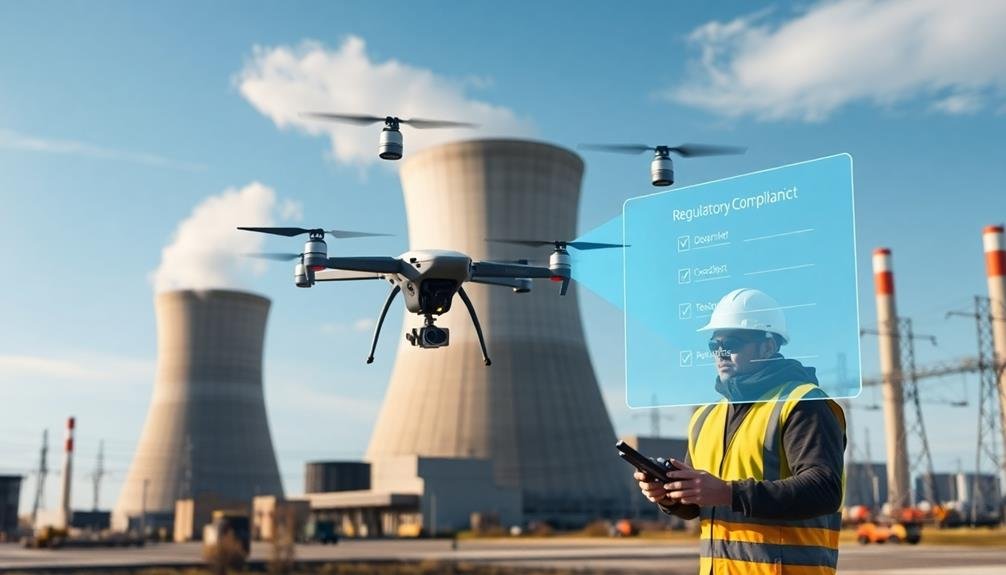
The regulatory landscape for UAV inspections in powerplants is complex and ever-evolving. You'll need to stay up-to-date with both federal and state regulations governing UAV operations in industrial settings. The Federal Aviation Administration (FAA) has specific rules for commercial drone use, including pilot certification, aircraft registration, and operational limitations.
You must also comply with energy sector-specific regulations and safety standards set by agencies like the Department of Energy and the Nuclear Regulatory Commission.
When conducting UAV inspections in powerplants, you'll face unique challenges that require careful attention to regulatory compliance:
- Maneuvering through restricted airspace around critical infrastructure
- Ensuring data security and protecting sensitive information
- Adhering to strict safety protocols in hazardous environments
To maintain compliance, you should develop a thorough UAV inspection program that includes regular training, rigorous documentation, and ongoing communication with regulatory bodies.
It's essential to establish clear procedures for pre-flight checks, risk assessments, and incident reporting. By prioritizing regulatory compliance, you'll not only avoid costly penalties but also enhance the safety and effectiveness of your UAV inspection operations in powerplants.
Safety Considerations for Drone Operations
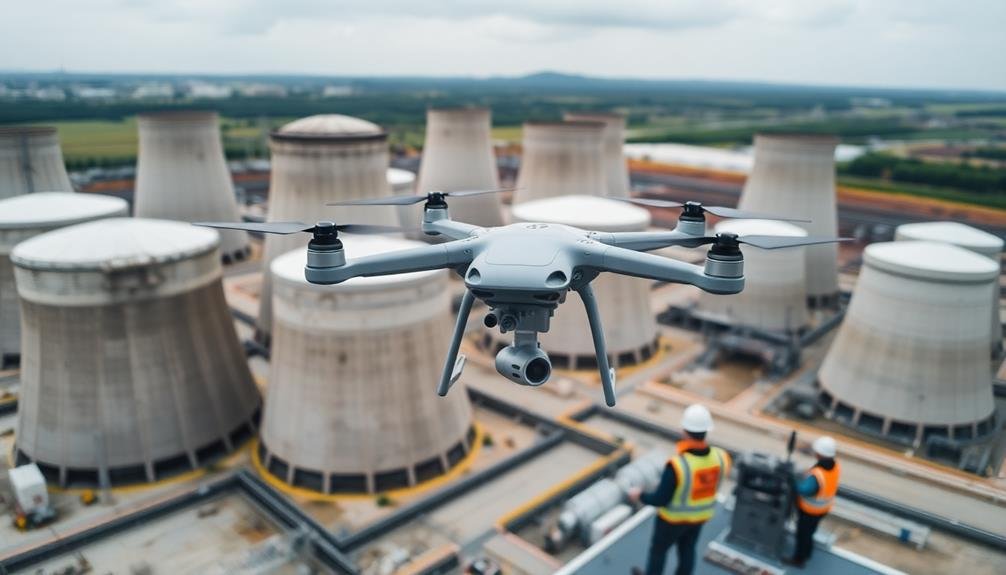
Safety considerations are paramount when conducting drone operations in powerplants. You must prioritize both personnel and equipment protection throughout the inspection process.
First, guarantee your drone operators are properly trained and certified for industrial inspections. They should be familiar with the specific hazards present in powerplant environments, such as high-voltage equipment and confined spaces.
Before each flight, conduct a thorough pre-flight checklist to verify the drone's airworthiness and functionality. This includes checking battery levels, propeller conditions, and sensor calibrations.
You'll need to establish clear communication protocols between the drone operator, safety personnel, and plant staff to coordinate movements and avoid potential conflicts.
Always maintain visual line of sight with the drone and adhere to designated flight paths. Be aware of obstacles like power lines, cooling towers, and other structures that could interfere with the drone's operation.
Implement fail-safe measures, such as return-to-home functions and emergency landing procedures, to mitigate risks in case of technical failures or loss of control.
Lastly, you must comply with all relevant safety regulations and guidelines set by both the powerplant and aviation authorities. This includes obtaining necessary permits and following specific operational restrictions within the facility.
Cost-Effectiveness of UAV Inspections
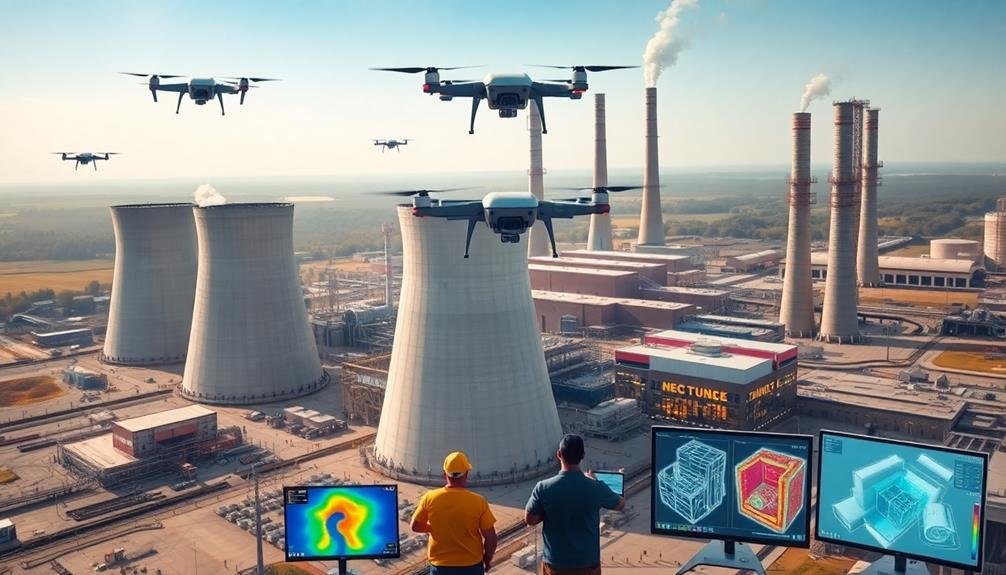
You'll find UAV inspections offer significant cost advantages for powerplants.
They'll reduce your labor costs by requiring fewer personnel and minimize expensive downtime through faster, more efficient inspections.
You'll also save on equipment expenses, as drones are often more affordable than traditional inspection tools and can access hard-to-reach areas without costly scaffolding or lifts.
Reduced Labor Costs
Implementing UAV inspections in powerplants can greatly reduce labor costs. You'll find that traditional inspections often require multiple workers, specialized equipment, and extensive safety measures. With UAVs, you can accomplish the same tasks with fewer personnel and less time. This efficiency translates directly into cost savings for your facility.
By using drones, you'll eliminate the need for scaffolding, cranes, or other expensive access equipment. Your team can inspect hard-to-reach areas without putting workers at risk, reducing potential liability and insurance costs. Additionally, you'll save on training expenses, as fewer specialized technicians are needed to operate UAVs compared to traditional inspection methods.
Consider these emotional benefits of reduced labor costs:
- Peace of mind knowing your workers are safer
- Pride in adopting cutting-edge technology to improve operations
- Satisfaction from allocating resources more efficiently
You'll also experience faster turnaround times for inspections, minimizing downtime and maximizing productivity. With UAVs, you can conduct more frequent inspections without incurring significant additional costs, allowing for better maintenance planning and preventing costly unplanned outages.
Ultimately, embracing UAV technology for powerplant inspections will streamline your operations and boost your bottom line.
Minimized Downtime Expenses
One of the most significant advantages of UAV inspections in powerplants is the drastic reduction in downtime expenses. When you employ drones for inspections, you'll find that the process is much quicker than traditional methods. This speed translates directly into cost savings, as your plant can resume operations sooner.
You'll notice that UAVs can access hard-to-reach areas without the need for scaffolding or shutting down entire sections of the plant. This targeted approach means you're only pausing operations in specific areas, rather than halting the entire facility. The result? Minimized production losses and increased overall efficiency.
Moreover, you'll appreciate the flexibility of scheduling UAV inspections. You can conduct them during planned maintenance periods or even during brief operational pauses, further reducing the impact on your plant's productivity.
With drones, you're no longer constrained by the limitations of human inspectors who might require extended periods of equipment shutdown.
Equipment Savings
Beyond reducing downtime expenses, UAV inspections offer significant equipment savings for powerplants. You'll find that traditional inspection methods often require costly specialized equipment, such as scaffolding, cherry pickers, or rope access systems.
UAVs eliminate the need for these expensive tools, drastically cutting your inspection-related expenses.
Furthermore, UAVs can access hard-to-reach areas without putting your staff at risk or damaging sensitive equipment. This means you'll spend less on repairs and replacements caused by human error during inspections.
The high-resolution cameras and sensors on UAVs can detect issues that might be missed by the naked eye, allowing for early intervention and preventing costly breakdowns.
Consider these emotional benefits of equipment savings through UAV inspections:
- Relief from the financial burden of maintaining expensive inspection equipment
- Pride in adopting cutting-edge technology that sets your powerplant apart
- Confidence in the accuracy and thoroughness of your inspection results
Training Requirements for UAV Operators
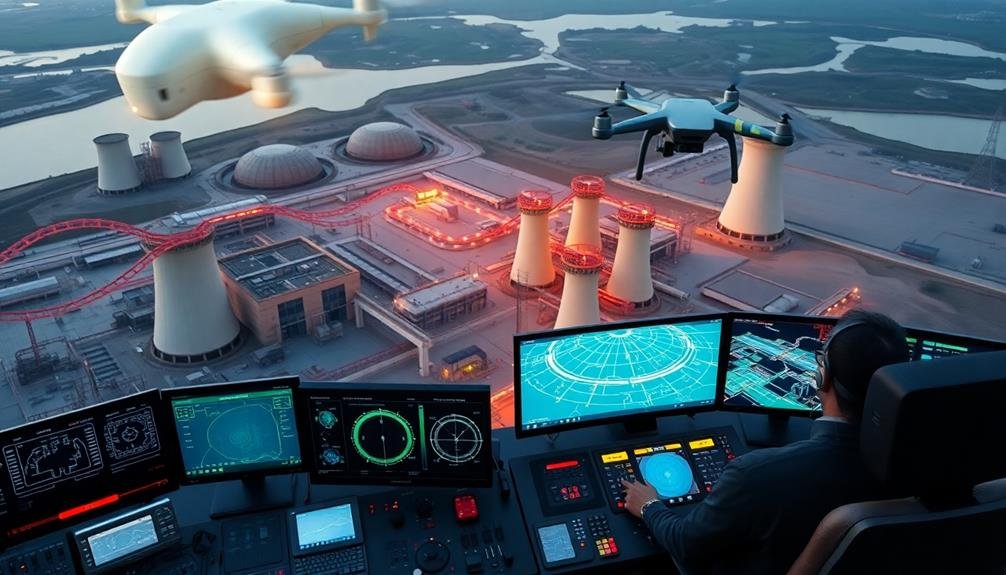
UAV operators tasked with powerplant inspections must meet rigorous training requirements to guarantee safe and effective operations.
You'll need to complete an extensive training program that covers both theoretical knowledge and practical skills. This includes understanding UAV systems, flight principles, and maintenance procedures.
You'll also need to master specific inspection techniques relevant to powerplants. This involves learning how to navigate complex structures, identify potential hazards, and capture high-quality imagery for analysis.
You'll be trained in emergency procedures and risk assessment to confirm you can handle unexpected situations during inspections.
Regulatory compliance is vital, so you'll need to familiarize yourself with local and national UAV regulations. You'll learn about airspace restrictions, privacy laws, and safety protocols specific to powerplant environments.
Ongoing training is essential to keep up with evolving technology and regulations. You'll participate in regular refresher courses and skill assessments to maintain your proficiency.
As UAV technology advances, you'll need to adapt to new equipment and software, confirming you're always operating at the cutting edge of powerplant inspection techniques.
Future Developments in Inspection Technology
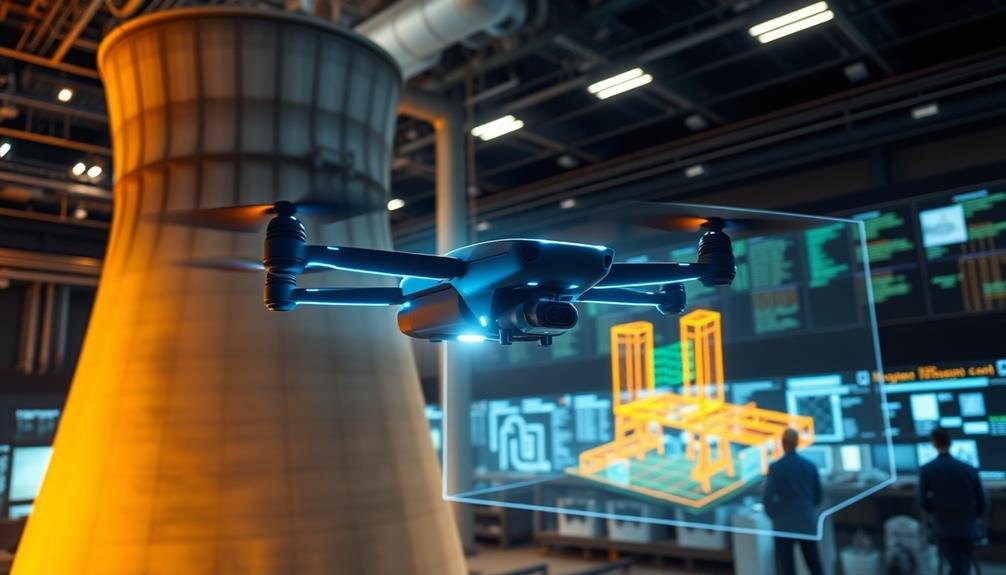
Rapid advancements in technology are set to transform powerplant inspections in the coming years. You'll see UAVs equipped with more sophisticated sensors, capable of detecting minute cracks, corrosion, and thermal anomalies with unprecedented accuracy.
Artificial intelligence and machine learning algorithms will process inspection data in real-time, providing instant insights and recommendations for maintenance teams.
Expect to witness the integration of augmented reality (AR) and virtual reality (VR) technologies in inspection processes. These tools will allow remote experts to guide on-site technicians, enhancing collaboration and reducing downtime.
Additionally, you'll encounter swarm robotics, where multiple UAVs work in tandem to inspect large facilities quickly and efficiently.
Future developments will evoke:
- Excitement as you witness UAVs maneuvering through complex structures autonomously
- Awe at the precision of AI-powered defect detection systems
- Relief knowing that predictive maintenance will prevent costly breakdowns
You'll also see advancements in battery technology, enabling longer flight times and increased payload capacity.
As these innovations unfold, powerplant inspections will become safer, more efficient, and increasingly data-driven, revolutionizing the industry and ensuring the reliability of our energy infrastructure.
Frequently Asked Questions
How Do UAVS Handle Extreme Weather Conditions During Power Plant Inspections?
You'll find UAVs handle extreme weather with specialized designs. They're equipped with stabilizers, weather-resistant materials, and advanced sensors. They can operate in high winds, rain, and extreme temperatures, ensuring safe and efficient power plant inspections.
Can Inspection Drones Detect Radioactive Materials in Nuclear Power Plants?
Yes, inspection drones can detect radioactive materials in nuclear power plants. They're equipped with specialized sensors that measure radiation levels. You'll find these drones invaluable for safely monitoring areas too dangerous for human inspectors to access directly.
What Cybersecurity Measures Protect UAVS From Hacking During Inspections?
You'll find UAVs protected by encryption, secure communications, and access controls. They're often equipped with anti-jamming tech and intrusion detection systems. Regular software updates and security audits guarantee your drones stay safe from cyber threats during inspections.
How Do UAVS Impact Local Wildlife When Conducting Power Plant Surveys?
You'll find UAVs can disturb wildlife during power plant surveys. They may startle birds, stress animals, or disrupt habitats. However, proper planning and low-impact flight paths can minimize these effects. Consider using quieter, less intrusive models.
Are There International Standards for UAV Inspections Across Different Countries?
You'll find that international UAV inspection standards aren't fully unified yet. While some countries collaborate on guidelines, there's still a lack of universal regulations. You should check local laws and industry best practices for each location you're operating in.
In Summary
You're witnessing a revolution in power plant inspections. UAV technology's transforming the industry, offering safer, more cost-effective, and efficient solutions. As you embrace these advancements, you'll see improved plant reliability and reduced downtime. Keep an eye on emerging tech like AI-powered drones and advanced sensors. They'll further enhance inspection capabilities. Stay informed, invest in training, and you'll be well-positioned to reap the benefits of this game-changing technology in the years to come.

As educators and advocates for responsible drone use, we’re committed to sharing our knowledge and expertise with aspiring aerial photographers.




Leave a Reply